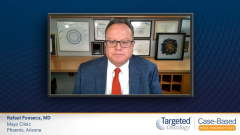
Considerations for Selecting First-Line Therapy in Newly Diagnosed Multiple Myeloma
Rafael Fonseca, MD, reviews first-line therapy options and considerations for treatment selection for patients with newly diagnosed multiple myeloma.
Rafael Fonseca, MD: In 2021, we go through the initial dichotomy of determining whether a patient is eligible for transplant. In our case, we have determined the patient is not. The second layer of decision regards whether the patient has high-risk disease. This is a topic that has been deemed very important in the past because it paved the way for selection of treatment. However, it is possible that in the future, particularly as we get better treatments, high-risk disease will be less relevant if we are to be giving the best treatment out there for all patients. Nevertheless, those are still very important criteria.
Once you do that, historically, people have approached the treatment of those who are of older age, or those who are not eligible candidates for transplant, more in a “control” mentality. But what we’re seeing with some of the clinical trials and data, which I will share with you later, is that control can be very deep. The depth of the responses, even without transplant, can be as deep as what we obtained historically with transplants. That changes both the perception and the philosophy of what to do with this patient population.
Of course, in patients who are younger, we often treat for the best response possible. I share with my patients that if we’re able to achieve the best-response possible—including MRD [minimal residual disease] negativity, which I think should be 1 of the key parameters for success in the treatment of myeloma—we should strive for that. That, in my opinion, will translate into cures for multiple myeloma for a subgroup of patients. I don’t know what fraction that is. Right now, we think most myeloma ultimately relapses. But we’re seeing patients who are several years post-treatment from induction with MRD negativity, without any evidence of disease recurrence. We can only hope that in time, more of those patients will remain with permanent control of their disease.
As we think about this, we must consider the practicalities of the clinical life factors. Such factors include the presence of cardiac disease, the presence of pulmonary disease, the psychosocial status of the patient, their ability to withstand some of the adverse effects of medication, and the support they’re going to have from family members for driving them to access their health care. There are many factors that come into play as we decide on the optimal treatment for patients. As of now, we don’t do personalized selection of treatment based on biology for the most part, meaning the treatments seem to be agnostic to most of the biological features that we see in myeloma.
This treatment plan may change in the near future, particularly as we learn more about the benefits of treatments that are more specific to some genetic mutations. But in spring 2021, most patients are treated agnostic to their specific biology. The major changes have been the duration of therapy and the addition of other agents of the class that we use at large for myeloma.
Transcript edited for clarity.
Case: A 77-Year-Old Woman with Multiple Myeloma
Initial Presentation
- A 77-year-old woman presents with decreased appetites, fatigue, and back pain
- PMH: unremarkable
- PE: pain during ambulation, point tenderness on palpation of the mid-back
- ECOG 1
Clinical Workup
- Hb 9.2 g/dL, corrected calcium 11.8 mg/dL, LDH 285 U/L, creatinine 2.1 mg/dL, albumin 3.8 g/dL, CrCl 45 mL/min
- Peripheral blood smear showed rouleaux formation
- Beta-2 microgloblulin 4.2 mcg/mL, M-protein 2.5 g/dL
- Lambda free light chains: 0.7 mg/dL, kappa free light chains: 13.3 mg/dL
- FISH: hyperdiploid
- UPEP: M-spike of 410 mg of lambda light chains in 24 hours
- PET/CT revealed lytic bone lesions in at L2/L3
- Bone marrow biopsy shows 60% plasma cells IgG k
- Diagnosis: R-ISS stage II MM
Treatment
- Patient is ineligible for ASCT due to comorbidities
- Initiated treatment with daratumumab + bortezomib + lenalidomide + dexamethasone









































